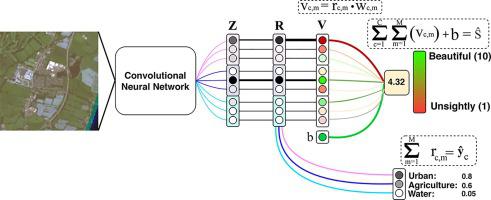ISPRS Journal of Photogrammetry and Remote Sensing ( IF 10.6 ) Pub Date : 2021-05-24 , DOI: 10.1016/j.isprsjprs.2021.04.020 Alex Levering , Diego Marcos , Devis Tuia

|
The environment where we live and recreate can have a significant effect on our well-being. More beautiful landscapes have considerable benefits to both health and quality of life. When we chose where to live or our next holiday destination, we do so according to some perception of the environment around us. In a way, we value nature and assign an ecosystem service to it. Landscape aesthetics, or scenicness, is one such service, which we consider in this paper as a collective perceived quality. We present a deep learning model called ScenicNet for the large-scale inventorisation of landscape scenicness from satellite imagery. We model scenicness with an interpretable deep learning model and learn a landscape beauty estimator based on crowdsourced scores derived from more than two hundred thousand landscape images in the United Kingdom. Our ScenicNet model learns the relationship between land cover types and scenicness by using land cover prediction as an interpretable intermediate task to scenicness regression. It predicts landscape scenicness and land cover from the Corine Land Cover product concurrently, without compromising the accuracy of either task. In addition, our proposed model is interpretable in the sense that it learns to express preferences for certain types of land covers in a manner that is easily understandable by an end-user. Our semantic bottleneck also allows us to further our understanding of crowd preferences for landscape aesthetics.
中文翻译:

关于景观美与土地覆盖之间的关系:以Sentinel-2分辨率在英国进行的具有可解释AI的案例研究
我们生活和重建的环境会对我们的福祉产生重大影响。更美丽的风景对健康和生活质量都有很大的好处。当我们选择居住的地方或下一个度假胜地时,我们会根据对周围环境的一些了解来选择。在某种程度上,我们重视自然并为其分配生态系统服务。景观美学(即风景)就是其中一种服务,我们在本文中将其视为一种集体感知的品质。我们提出了一个名为ScenicNet的深度学习模型,用于从卫星图像中大规模景观化风景名胜。我们使用可解释的深度学习模型对风景进行建模,并基于从英国超过20万幅风景图像中得出的众包评分,学习风景秀丽估算器。我们的ScenicNet模型通过将土地覆盖率预测作为景观回归的可解释中间任务来学习土地覆盖类型与景观之间的关系。它可以同时从Corine Land Cover产品预测景观和土地覆盖,而不会影响任何一项任务的准确性。此外,我们提出的模型在某种意义上是可以解释的,因为它学会了以最终用户易于理解的方式表达对某些类型土地覆盖物的偏好。我们的 我们提出的模型在某种意义上是可以解释的,因为它学会了以最终用户易于理解的方式表达对某些类型土地覆盖物的偏好。我们的 我们提出的模型在某种意义上是可以解释的,因为它学会了以最终用户易于理解的方式表达对某些类型土地覆盖物的偏好。我们的语义瓶颈还使我们能够进一步了解人群对景观美学的偏好。











































 京公网安备 11010802027423号
京公网安备 11010802027423号